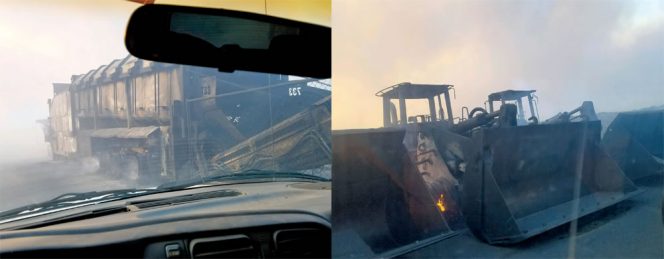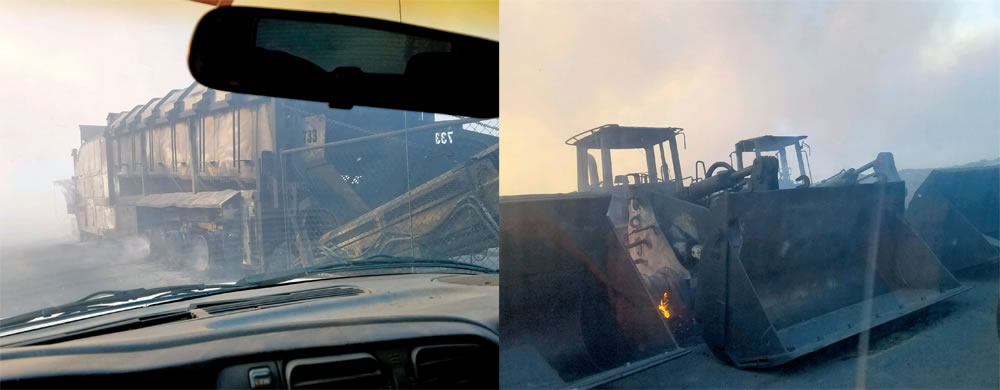Craig Coker
BioCycle January 2019

At 3:44 am on Dec. 5, 2017, a wildfire was reported in the Angeles National Forest. Shortly after, the Los Angeles Fire Department notified the Lopez Canyon Environmental Center (LCEC) that the fire was approaching the composting facility. Photo courtesy of Lopez Canyon Environmental Center
Fires at composting and mulching facilities happen frequently. A minor fire threatens to attract public inquiry about the risks and nuisances of mulching or composting activities at a particular site, and within the industry generally. A major fire threatens a multimillion dollar investment and presents a potential danger to workers and firefighters.
Fires can be caused by human error (e.g., a carelessly-discarded cigarette), improper procedures (e.g., a welding spark from doing equipment repair next to a pile of material), lightning, arson, spontaneous combustion and wildfires. This article examines those last two causes.
Spontaneous Combustion
Spontaneous combustion in compost has been covered in BioCycle (see “Fires at Composting Facilities: Causes and Conditions,” January 2000). The author, Robert Rynk, PhD, wrote: “In the chain of reactions that leads to spontaneous combustion, the biological processes create temperatures high enough to sustain heat-releasing chemical reactions. The chemical processes include chemical oxidation, slow pyrolysis, and adsorption or condensation of gases within dry charred particles. In particular, chemical oxidation of dry materials noticeably increases at around 80°C (175°F). For moist materials — when there is enough moisture to feed the process, but not enough to cool the pile — the threshold temperature is slightly lower because water facilitates or catalyzes chemical oxidation (as it does when wet iron oxidizes to rust).
“As the temperature increases, chemical oxidation happens even faster, and the material accelerates toward ignition temperatures. In large piles of organic materials, with limited available oxygen, spontaneous combustion usually leads to a smoldering fire, generally at temperatures between 150° to 200°C (300°F to 400°F). If enough oxygen is suddenly supplied by the aeration system or by opening up the pile, temperatures will increase immediately and dramatically to create a flaming fire.
“Key conditions that lead to spontaneous combustion are biological activity, relatively dry materials or dry pockets, large well-insulated piles or vessels, limited air flow, and time for temperature to build up. In addition, there may be other contributing factors such as short circuiting of air flow, a nonuniform mix of materials, poor moisture distribution, difficulty in knowing temperatures throughout a pile, and sometimes a lapse or oversight in monitoring.”
Case Study: Houston, Texas
The Ground Up is a green waste recycling company in Houston. Founded in 2010, the company is now a subsidiary of Ceres Environmental, which has been in the disaster relief business for over 30 years. The Ground Up has a fleet of 5 grinders at its three sites, including the 27-acre Windfern facility that handles 150,000 to 200,000 cubic yards (cy)/year of green waste, including vegetative debris from Hurricane Harvey that hit the Houston area in August 2017. The piles of unground and ground materials are limited to 25-foot heights by the fire department and have 30-foot access lanes per Texas Commission on Environmental Quality regulations.
The spontaneous combustion fire began on Monday August 14, 2017 in a pile of ground green waste that had been sitting on-site for about three-and-a-half months. The operators normally pile up ground material to the height of the loader buckets so as not to have to drive up on the pile, but, this particular pile had been “double-stacked” or built up to about 18- to 20-feet tall, to conserve space. The double-stacking was necessary as four of The Ground Up’s five grinders were deployed elsewhere for Ceres Environmental’s disaster response to Hurricanes Irma and Maria. The remaining grinder couldn’t keep up with the incoming flow of materials.
“Three critical factors came together to create the perfect storm for a fire: a one-half inch rain on the previous Sunday morning, a south wind of 12 to 14 miles per hour (mph) that lasted until Monday night, and a pile processing and screening method on the south end of the pile that exposed an 18-foot high by 70-foot wide vertical wall of ground material to the wind,” explains Grant Williamson, General Manager of The Ground Up. “The wind fanned the smoldering green waste and caused it to flame up. The whole pile was engulfed in open flames within 30 minutes.”
The responding fire department elected not to douse the burning pile with water but rather to soak the adjacent piles with water to slow any spread of flames. They also doused the firm’s Backers 3-MTA star screen that was being used to screen the pile when the fire broke out, but the screen was lost to the fire. Staff at The Ground Up used an excavator to smother the burning pile by turning it in place and smothering the embers.
The Ground Up had an existing relationship with the fire department. An inspection took place in March 2018 and the fire department staff had some familiarity with fighting mulch fires, which helped keep this one fire from spreading across the site. “Since that fire, several new procedures have been put in place to prevent another occurrence,” adds Williamson. “We have increased our temperature monitoring frequency from once per week and we are turning our piles more often to dissipate any heat build-up. In hindsight, I am very grateful to the fire department that this event wasn’t a bigger problem for us.”
Wildfires
Wildfires are started by lightning strikes and by careless or malicious human behavior. Vegetative material such as forest fuels ignites at relatively low temperatures provided the amount of moisture in the fuel is low and it is exposed to the air so that sufficient oxygen is available. Actual heat requirements for ignition of dead forest fuels varies from about 500°F to 750°F. Many common ignition sources will provide enough heat — including a burning match, a firecracker or a glowing cigarette — when in contact with fine fuels that are dry.
A wildfire spreads by transferring heat energy three ways: radiation, convection and conduction. Radiation is the transfer of heat energy in straight-line waves (stand in front of a fireplace; only your front feels warm, not your back). Radiation predries and preheats the forest’s fuel, growing in intensity as the fire front gets closer.
Convection is the transfer of heat by the physical movement of hot masses of air. As the air is heated it expands, becomes lighter, and rises, being replaced by cooler air coming in from below (the same as the mechanism of heat transfer in an active compost pile). The convection in a forest fire is much stronger, and the cooler air it pulls in provides additional oxygen for the combustion process. If strong enough, convection can produce extreme wind speeds and what is called a “firenado” (a fire tornado).
Conduction is the transfer of heat within the material itself. Although wood itself is a poor conductor of heat, lighter forest materials like leaves and grasses burn quickly. Fire spreads as these lighter materials get entrained in the convection column and embers get spread by the convective currents of air. Fire also spreads faster going up a slope, aided by the combination of conduction and convection. Fire spread rates are on the order of 6 mph in forests and 14 mph in grasslands; with a 10 percent upslope, those rates will double.
Case Study: Sylmar, California
At 3:44 a.m. on December 5, 2017, a wildfire was reported in the Angeles National Forest north of Los Angeles, about four miles east of the City of Sylmar. Called the Creek Fire, the wildfire spread rapidly, consuming over 15,300 acres and destroying 65 homes and structures by 6 a.m. the following morning. By the time the fire was fully contained on January 9, 2018, over 120 homes and structures were destroyed and another 71 damaged.

Photos taken from the safety of a vehicle illustrate the level of devastation at the LCEC. High winds at 50 mph spread the Creek Fire through the site, quickly engulfing large equipment. Photos courtesy of Lopez Canyon Environmental Center
The City of Los Angeles Sanitation Department (LASAN) owns the now closed Lopez Canyon Landfill east of Sylmar. A section of the landfill has been dedicated for the Lopez Canyon Environmental Center (LCEC), which opened in 2003, where green waste is collected and ground into mulch for reuse by residents of Los Angeles. A portion of the green waste is composted in windrows to make TOPGRO soil amendment. The facility is limited by its permit to a maximum storage capacity of 12,500 cy of material, including incoming yard and green waste, and mulch and compost piles.
Shortly after the fire was reported, the Los Angeles City Fire Department, which has co-located facilities at the LCEC, notified the Center’s security guard that the fire was approaching. “The guard notified me right away,” notes Manuel Gomez, the site manager for the LCEC, “and I left immediately. My home is about 20 minutes’ drive from the LCEC, and by the time I got there, the fire had spread across our open areas by burning the grass and the entire facility was engulfed in flames. The wind was blowing at about 50 mph, and the embers from the fire were scattered everywhere. Both our compost processing equipment and the nearby construction equipment of one of our contractors caught fire from burning embers of melted plastic trashcans that staff used for contaminants removed from the incoming feedstocks and from burning embers of melted PVC pipe used for landfill gas collection.”
Gomez adds that LASAN is now implementing a protocol to move equipment away from compost and mulch processing areas during periods of elevated fire risk. “One problem we encountered is most of our processing equipment is stationary,” he says. “The heavy weight of the equipment, up to 78,000 pounds, indented the leveling legs into the asphalt. We had welded extra supports onto the legs to stabilize the equipment, so those extra supports would have to be removed prior to moving the equipment.” LASAN is beginning to replace that stationary equipment with smaller trailer-mounted equipment. Its new grinder is mobile and equipped with tracks.
Another complication was that the Fire Department said it had more pressing issues to deal with than the fire at the LCEC, so LCEC staff was on its own to combat the blaze. “My staff know how to put out a compost or mulch fire, in some cases, more than fire fighters, so we are normally able to deal with small fires,” explains Gomez. “This Creek Fire came up so fast, and spread so rapidly, that there was nothing we, or the Fire Department could do. I’m just very thankful no lives were lost, and no one was injured.”
Craig Coker is a Senior Editor at BioCycle and CEO of Coker Composting & Consulting near Roanoke, VA. He can be reached at ccoker@jgpress.com.













